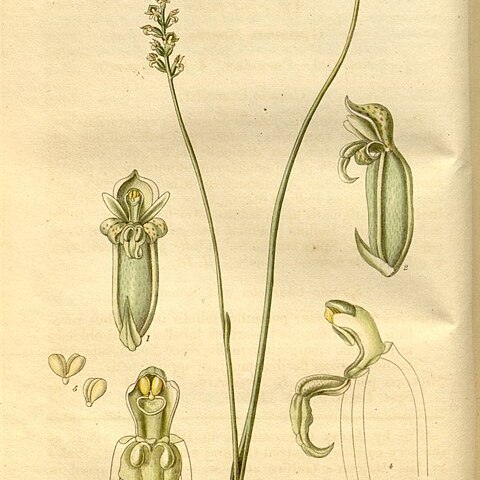Plant at fl. 10–30–(70) cm. tall. Stem erect, ± fleshy. Lf often overtopping raceme. Raceme of very ∞, us. crowded fls. Per. green to yellowish green. Dorsal sepal c.1.5–2mm. long, with short recurved tip; laterals shorter, subacute, deflexed. Petals ± under dorsal sepal. Labellum broad at base, narrowing towards obtuse tip which ends in a down-turned apiculus; margin entire (marginal cells occ. slightly enlarged), smooth; anterior callus us. present in N.Z., variable in size; basal calli prominent, sts appearing as 2 pairs, surrounding a small pouch which causes a bulge on the under side of labellum, so preventing it from lying flat against ovary. Column narrow below stigma; wings membr. throughout.
Leaf 200–300 × 2–4 mm. Inflorescence 200–300 mm long, 20–50-flowered. Pedicels c. 0.5 mm long. Flowers moderately crowded, 2.5–3 × 2–2.5 mm, green. Dorsal sepal c. 2.5 × 2 mm, obliquely erect, elliptical to round, concave, very small apical point. Lateral sepals tightly inrolled, lanceolate, c. 3 × 0.8 mm, apex blunt. Petals narrowly lanceolate, c. 2 × 0.4 mm, erect within dorsal sepal or spreading, blunt or pointed. Labellum cordate, c. 2.5–3 × 2 mm, recurved, held away from ovary, margins entire, wavy, tapered from near middle to distinctly pointed apex. Basal callus of 2 narrow, dark green, raised, confluent mounds; apical callus minute, pale green.
Leaf 150–300 × 4–6 mm. Inflorescence 150–300 mm long, 20–60-flowered. Pedicels 0–0.3 mm long. Flowers crowded, 2–2.5 × c. 2 mm, green to yellowish green. Dorsal sepal erect, oblong-ovate, c. 2 × 2 mm, concave, prominent apical point. Lateral sepals oblong, c. 1.5–2 × 0.5 mm, incurved to inrolled, bluntly pointed. Petals erect within dorsal sepal, linear, c. 1.2 × 0.3 mm. Labellum porrect at base then recurved, wedge-shaped to somewhat triangular, c. 1.8–2 × 1 mm, margins irregular; apex truncate with a short point. Basal callus of 2 separate dark green mounds (sometimes comma-shaped); apical callus dark green, raised, flat.
Leaf 100–400 × 3–6 mm. Inflorescence 100–350 mm long, stiff, 10–50-flowered. Flowers moderately crowded, 3–3.5 × 2–2.8 mm, green. Dorsal sepal obliquely erect, oblong to elliptical, c. 2.5 × 2 mm, concave, small apical point. Lateral sepals inrolled, oblong, c. 2.3 × 0.9 mm, apex pointed. Petals narrowly oblong, c. 1.8 × 0.5 mm, erect within dorsal sepal. Labellum oblong to rectangular, narrowed above middle, c. 2 × 1.3 mm, margins with many cell-clusters, apex broadly and shallowly notched. Basal callus of 2 dark green, raised, flat mounds, appearing fused; apical callus shallower, less obvious.
Leaf 200–500 × 3–6 mm. Inflorescence 200–500 mm long, 10–80-flowered. Pedicels 0–0.5 mm long. Flowers well spaced, 2–2.3 × 1.8–2.2 mm, green to yellowish green. Dorsal sepal erect, broadly elliptic, c. 2 × 2 mm, concave, small apical point. Lateral sepals oblong, c. 2 × 0.8 mm, incurved to inrolled, apex cymbiform. Petals erect within dorsal sepal, linear, curved, c. 1.2 × 0.3 mm, apex blunt. Labellum heart-shaped, c. 1.4–1.8 × 1–1.3 mm, margins entire; apex bluntly rounded. Basal callus of 2 separate, dark green mounds longer than wide; apical callus absent or a sparse group of cells.

